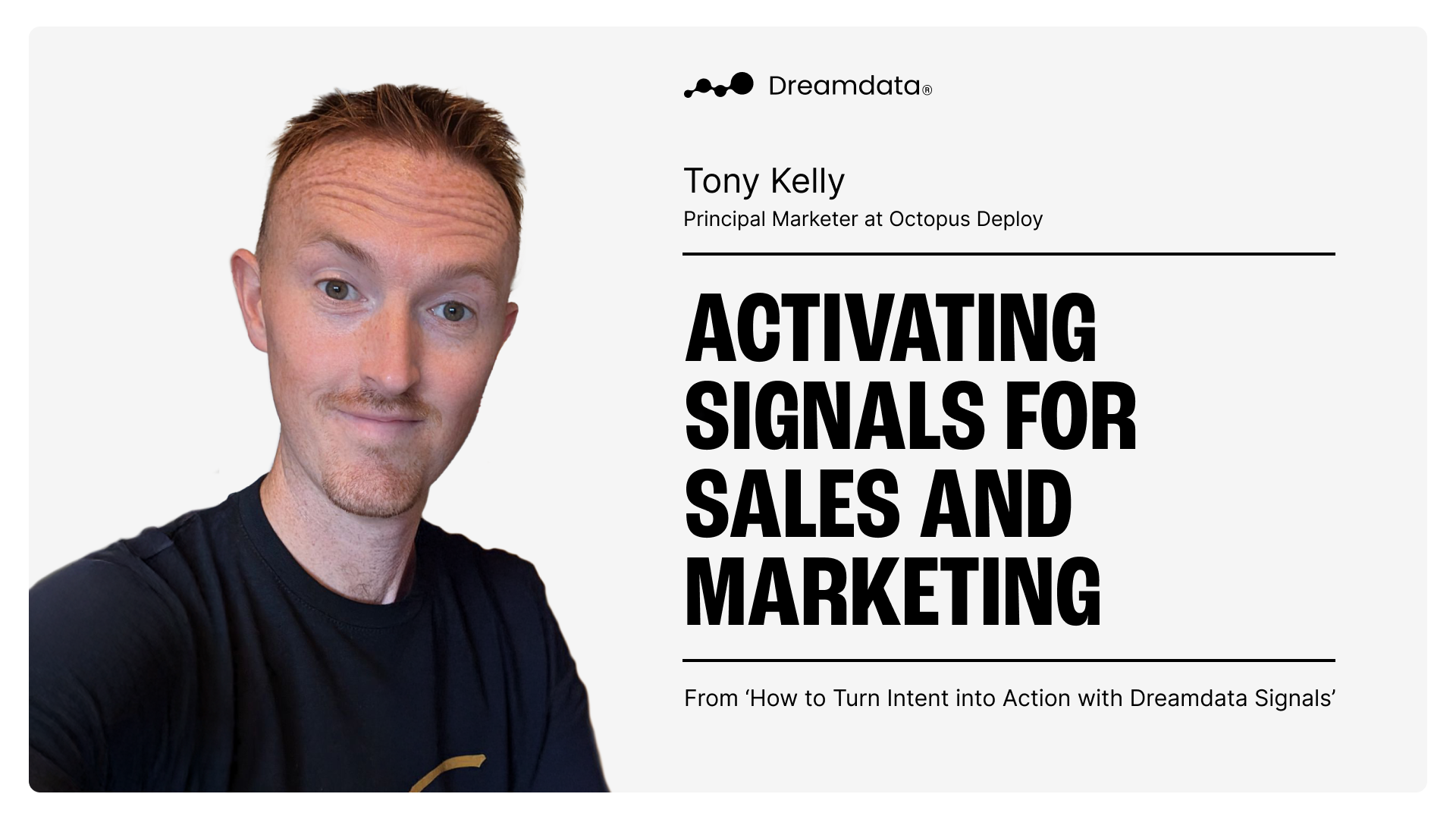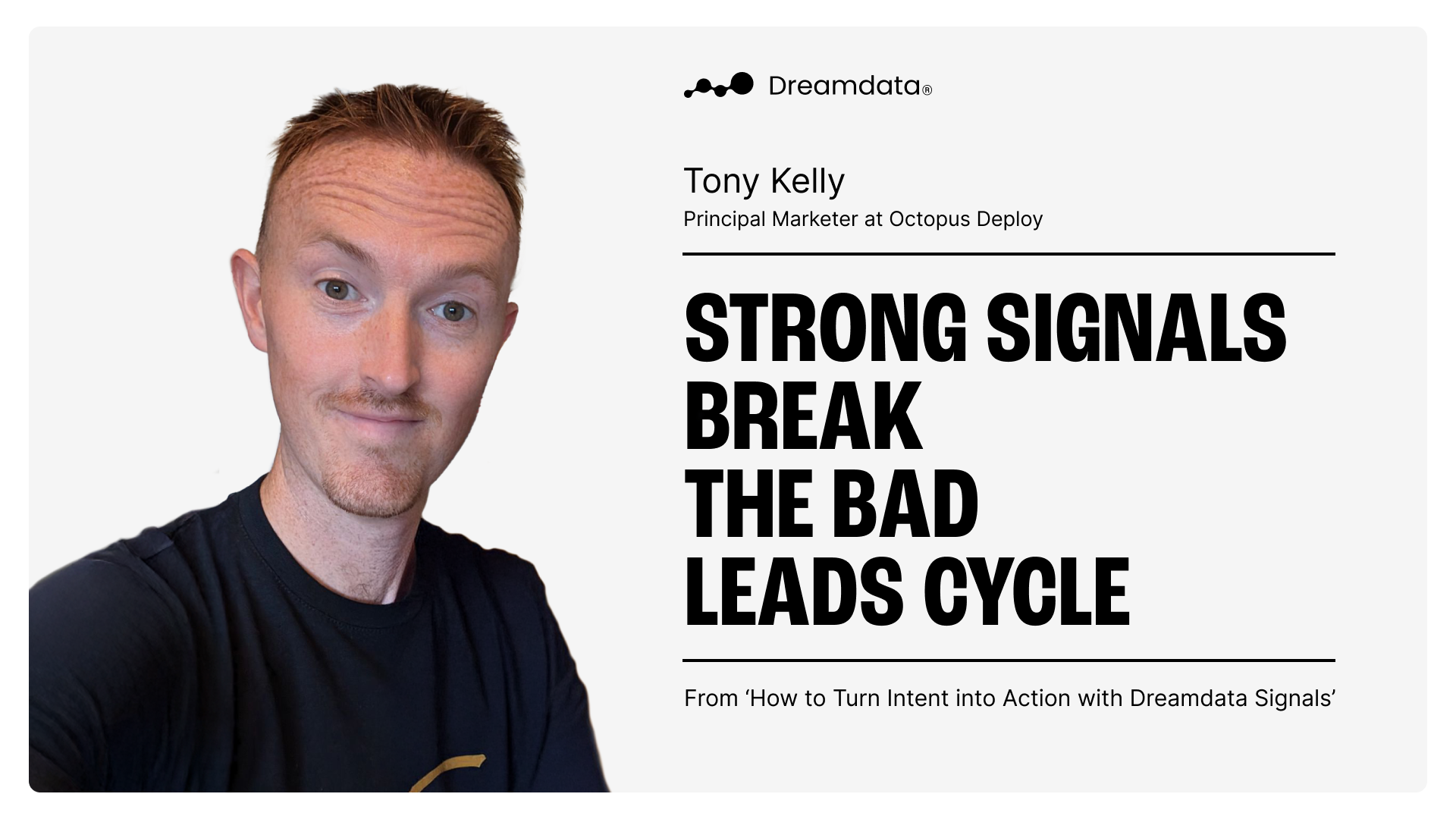How to Turn Intent into Action with Dreamdata Signals
For B2B marketers, every website visit, download, and registration is tracked, but most of this information isn't a reliable indicator of a customer's intent to buy. The result is a surplus of low-quality data that creates more work than value.
The solution is to identify the right behavioral signals and act on them effectively.
In a recent panel for the attributed podcast, marketing leaders Austin Sandmeyer, Tony Kelly, and Mathilde Dechansiaud shared a practical framework for this.
They explained how to define meaningful signals, align with sales teams, and build automated systems that turn specific customer actions into predictable revenue.
Keep reading for all the takeaways, or watch the entire conversation here.
TL;DR: This article breaks down expert advice on how to identify high-value signals of buyer intent, align with sales, and use automation to generate revenue from that data.
From "Intent Data" to Actionable Signals
The term ‘intent data’ has gotten a modern rebrand to ‘signals’, and for good reason.
According to Austin, the term needed a refresh because the game has changed from tracking simple engagement to understanding a sophisticated constellation of behaviors.
This includes first-party signals from your own digital properties, like a visit to the pricing page; third-party signals from other sites, such as G2 reviews; and broader contextual signals, like a target company’s recent funding round.
The key is to combine these data points.
A lot of it is noise, but a lot of it is gold. You want to make sure you're utilizing this data in the right way to really optimize your campaigns. - Mathilde
A single data point is rarely a true signal, but a pattern of actions is what indicates genuine interest.
Why is a Signal-Based Strategy Necessary?
For modern B2B marketers, focusing on signals is a strategic requirement for three clear reasons.
Connecting Marketing Work to Pipeline
A signal-based strategy provides a direct, evidence-based link between marketing activities and their impact on the sales pipeline.
If you can get it to connect to pipeline, you're in a good place. - Tony
Improve Budget Efficiency
In an era of tight budgets, signals allow teams to focus their ad spend and sales outreach on accounts that are actively in-market. This dramatically increases efficiency and prevents wasting resources on audiences that are not yet ready to buy.
Engage Buyers Earlier
Much of the buyer's research process now happens independently before they contact a sales representative. Identifying early signals is a great way to engage with potential customers at the right time.
How to Activate Your Signals
Identifying a signal is one thing; acting on it is another. A modern GTM strategy uses signals to empower both sales and marketing teams.
Equipping Sales with Actionable Intelligence
To avoid overwhelming sales teams, the focus must be on delivering pre-qualified, relevant information.
At Octopus Deploy, this takes the form of curated notifications in regional Slack channels. Tony Kelly also explains that the team turns a combined engagement score built from high-intent signals plus a good ICP match into prioritized alerts.
This alignment is critical. At Oyster, marketing and sales teams work on the same accounts from the start, creating a unified process for nurturing leads.
Sendoso takes it a step further, using AI to generate a complete synopsis for its account executives, summarizing a lead's origin and recent activities.
Automating Marketing to Nurture at Scale
For accounts that are warming up but not yet sales-ready, marketing automation is essential.
Signals are used to create dynamic audiences for ad platforms, moving high-intent accounts into more direct, bottom-of-funnel campaigns. Many lower-intent signals can trigger automated but personalized email sequences, saving countless hours of manual work and ensuring no potential lead is left behind.
This nurturing process is vital for long-term success. Staying in contact with helpful, relevant content is what converts initial interest into a future sales opportunity.
For more ways to activate your signals, check out this blog post.
How to Find Your Most Valuable Signals
While the right signals are different for every company, the method for finding them is the same: collaborate with your sales team.
Austin says the most important insights come from asking sales one simple question: What makes a deal move faster? He explains how to analyze your successful deals to find your company's most valuable buying signals.
For Mathilde, a key indicator is the use of high-intent website tools, like an on-site cost calculator, which suggests a prospect is very close to making a hiring decision.
According to the panel, other powerful signals include late-stage due diligence behaviors, such as viewing community forums, G2 comparison pages, or even engaging with referral programs where a prospect can ask to speak with a current customer.
A Playbook for Getting Started
For B2B marketers looking to transform their own mountain of data, the path forward hinges on a unified, collaborative strategy.
Start with Your Top Performers
The best signals often come from understanding what your top reps already know. Talk to them to reverse-engineer what makes a dream account, then build a system to find more of them.
Unify Your Technology Stack
Signals are useless when trapped in different platform silos. Consolidating disparate data into a unified platform is critical for both analysis and activation.
Co-Build Your Process with Sales
Success depends on developing your signal-based playbooks with the sales team, not just for them. This prevents the common conflict where marketing provides leads that sales deems low-quality.
Tony emphasized that a shared definition of a good signal is key to alignment.
Conclusion
As the panel illustrates, success no longer comes from having the most data, but from having the clearest understanding of what it means.
By fostering deep collaboration with sales, leveraging technology to unify insights, and relentlessly focusing on the customer behaviors that matter, marketing teams can finally unlock predictable, scalable growth.
About the Panelists
Austin Sandmeyer is the Director of Growth & GTM Engineering Strategy at Sendoso, a leading swag management and corporate gifting platform. His work is centered on pipeline generation and building automated, signal-based go-to-market motions.
Mathilde Dechansiaud is the Lead Manager of Demand Generation at Oyster, a global employment platform that helps companies hire talent anywhere. She specializes in driving brand awareness and pipeline with the right audiences, working in close alignment with sales and revenue operations.
Tony Kelly is a Principal Marketer at Octopus Deploy, a continuous delivery platform designed for technical software teams. He focuses on connecting marketing efforts to pipeline, particularly for highly technical audiences like DevOps and platform engineers.







